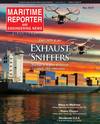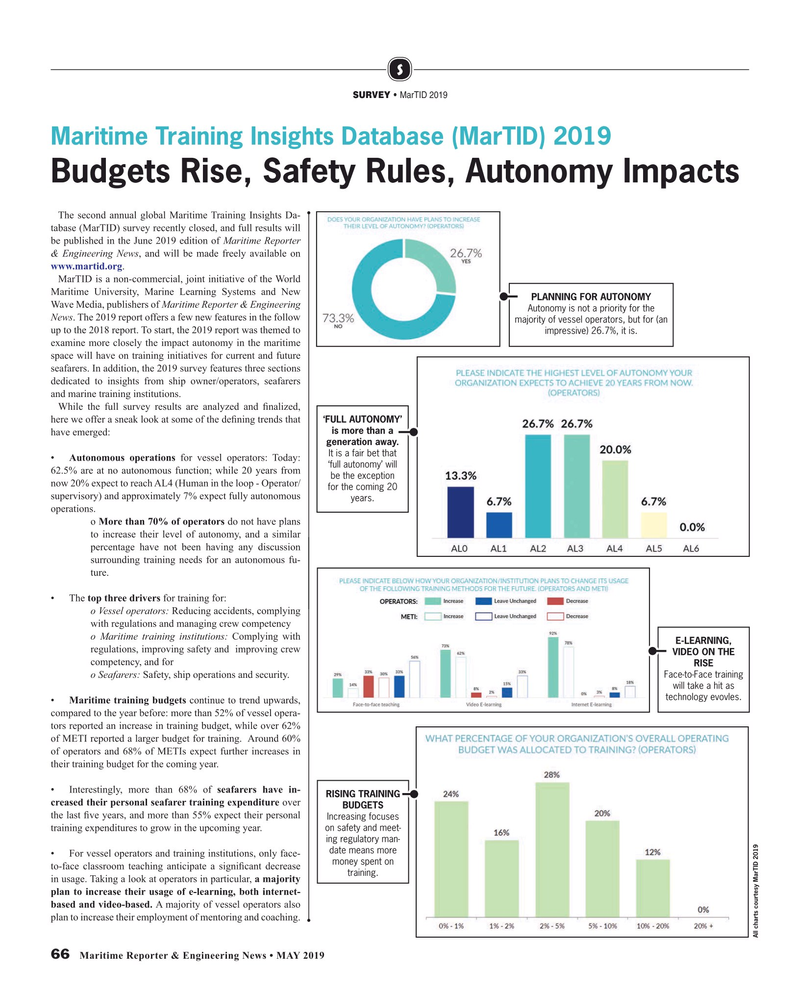
Page 66: of Maritime Reporter Magazine (May 2019)
Propulsion Annual - Green Marine Tech
Read this page in Pdf, Flash or Html5 edition of May 2019 Maritime Reporter Magazine
S
SURVEY • MarTID 2019
Maritime Training Insights Database (MarTID) 2019
Budgets Rise, Safety Rules, Autonomy Impacts
The second annual global Maritime Training Insights Da- tabase (MarTID) survey recently closed, and full results will be published in the June 2019 edition of Maritime Reporter & Engineering News, and will be made freely available on www.martid.org.
MarTID is a non-commercial, joint initiative of the World
Maritime University, Marine Learning Systems and New
PLANNING FOR AUTONOMY
Wave Media, publishers of Maritime Reporter & Engineering
Autonomy is not a priority for the
News. The 2019 report offers a few new features in the follow majority of vessel operators, but for (an up to the 2018 report. To start, the 2019 report was themed to impressive) 26.7%, it is. examine more closely the impact autonomy in the maritime space will have on training initiatives for current and future seafarers. In addition, the 2019 survey features three sections dedicated to insights from ship owner/operators, seafarers and marine training institutions.
While the full survey results are analyzed and ? nalized, here we offer a sneak look at some of the de? ning trends that ‘FULL AUTONOMY’ is more than a have emerged: generation away.
It is a fair bet that • Autonomous operations for vessel operators: Today: ‘full autonomy’ will 62.5% are at no autonomous function; while 20 years from be the exception now 20% expect to reach AL4 (Human in the loop - Operator/ for the coming 20 supervisory) and approximately 7% expect fully autonomous years. operations.
o More than 70% of operators do not have plans to increase their level of autonomy, and a similar percentage have not been having any discussion surrounding training needs for an autonomous fu- ture. • The top three drivers for training for: o Vessel operators: Reducing accidents, complying with regulations and managing crew competency o Maritime training institutions: Complying with
E-LEARNING, regulations, improving safety and improving crew
VIDEO ON THE competency, and for
RISE
Face-to-Face training o Seafarers: Safety, ship operations and security.
will take a hit as technology evovles. • Maritime training budgets continue to trend upwards, compared to the year before: more than 52% of vessel opera- tors reported an increase in training budget, while over 62% of METI reported a larger budget for training. Around 60% of operators and 68% of METIs expect further increases in their training budget for the coming year. • Interestingly, more than 68% of seafarers have in-
RISING TRAINING creased their personal seafarer training expenditure over
BUDGETS the last ? ve years, and more than 55% expect their personal
Increasing focuses on safety and meet- training expenditures to grow in the upcoming year.
ing regulatory man- date means more • For vessel operators and training institutions, only face- money spent on to-face classroom teaching anticipate a signi? cant decrease training. in usage. Taking a look at operators in particular, a majority plan to increase their usage of e-learning, both internet- based and video-based. A majority of vessel operators also plan to increase their employment of mentoring and coaching.
All charts courtesy MarTID 2019 66 Maritime Reporter & Engineering News • MAY 2019
MR #5 (66-73).indd 66 5/3/2019 1:50:20 PM

 65
65

 67
67
